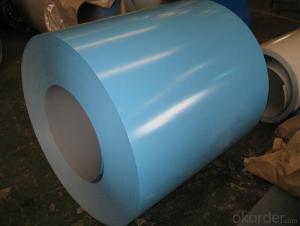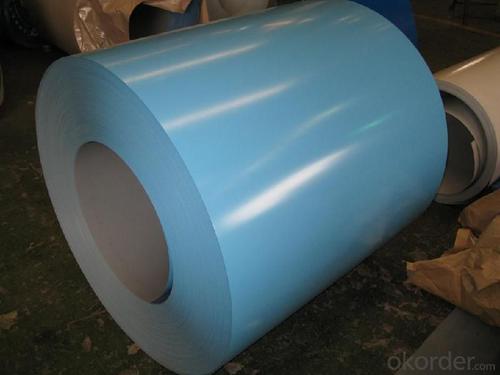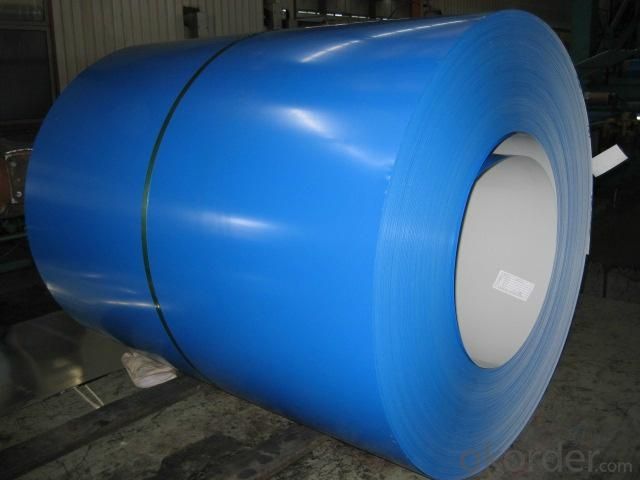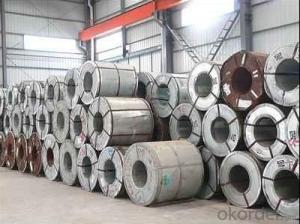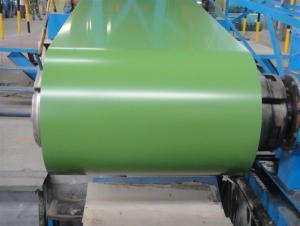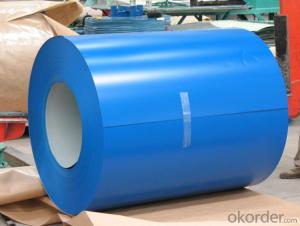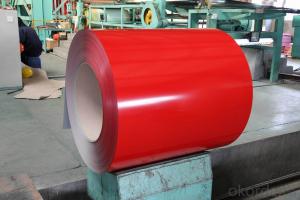Prepainted Gavalume Steel Coils
- Loading Port:
- China Main Port
- Payment Terms:
- TT OR LC
- Min Order Qty:
- -
- Supply Capability:
- -
OKorder Service Pledge
OKorder Financial Service
You Might Also Like
Name | G1 - AS1397 Hot Dip 55% Al-Zn Coated Steel Coil |
Grade | GB/T-12754: 2006, JIS3302, EN 10142, ASTM A653, JIS G3302, SGCC/SGCH, GB/T2518, European Standard, ASTM A792, JIS G3321, JIS G3317 |
BASE PLATE | Cold rolled steel sheet, hot dipped zinc coated steel sheet hot dipped A-Z coated steel sheet |
EQUIPMENT | Double coating double baking; |
CAPACITY | 5000Mt/week |
SIZE | Thickness 0.18mm—2mm, width 40mm—1250mm |
ZINC COATING | 40g-275g /m2 |
PAINT THICKNESS | Top:20+-5um, back:5-7um |
COIL WGT | 3Mt - 8Mt |
COIL ID | φ508mm,φ610mm |
BASE SHEET | Cold rolled steel sheet, hot dipped zinc coated steel sheet (small, regular or zero spangle), hot dipped A-Z coated steel sheet |
SURFACE PAINT | EP, PE, HDP, SMP, PVDF |
COLOR SERIES | RAL color number series |
- Q: That's my question, well that and:Steel Pick + Electric Guitar = Trashed Guitar?:D
- Uh. . . your guitar would be okay. . . except your strings wouldn't last long then nylon strings.
- Q: How are steel coils processed for different finishes?
- Steel coils are processed for different finishes through various techniques such as hot rolling, cold rolling, pickling, and coating. Hot rolling involves heating the steel coils and passing them through rollers to achieve desired thickness and shape. Cold rolling further enhances the surface finish by reducing thickness and increasing strength. Pickling involves removing impurities and scale from the surface of the steel coils using acid solutions. Finally, coating techniques like galvanization or painting are used to provide protective and decorative finishes to the steel coils.
- Q: What is the role of steel coils in the manufacturing of bridges?
- The role of steel coils in the manufacturing of bridges is to provide a strong and durable material for the construction of various components such as beams, girders, and columns. These coils are made from high-quality steel that is capable of withstanding heavy loads and extreme weather conditions, ensuring the structural integrity and longevity of the bridge. The steel coils are shaped and processed into the desired sections and sizes, making them essential in the fabrication and assembly of bridge elements.
- Q: Steel Strings on your guitar or nylons? Why?
- There is no OR about it. You CANNOT use steel strings on a nylon string guitar because the increased tension will actually warp the top of the guitar and eventually pull the bridge right off! (I have seen it happen several times!) Although it is possible to put nylon strings on a steel string guitar it is not recommended. Nylon strings do not have as much tension as a steel string guitar is designed for. Steel string guitar necks are actually designed with a bit of back bow to compensate for the high tension of steel strings. Nylon strings have a much lower tension which could cause the neck of a steel string to settle slightly, which could actually cause the strings to fret out. It is not common, but it does happen. So keep your guitars happy and only string them with the proper strings.
- Q: How is the quality of steel coils determined?
- The quality of steel coils is determined through various tests and inspections, including visual examination, dimensional inspection, mechanical properties testing, and chemical analysis. These assessments help identify defects, such as surface imperfections, cracks, or variations in thickness and width, as well as ensure the desired mechanical properties and chemical composition of the steel.
- Q: How are steel coils protected from corrosion?
- Steel coils are protected from corrosion through a variety of methods, including applying a protective coating such as zinc or polymer, using corrosion inhibitors, storing the coils in a controlled environment with proper ventilation and humidity control, and implementing regular inspection and maintenance practices to identify and address any potential corrosion issues promptly.
- Q: Is it possible that stainless steel watches get rust. Any experience? Thanks.
- Stainless Steel comes in many different grades, a prime example is to see if a magnet sticks to it if so it has a high iron content as the grade of the stainless increases its magnetic ,iron properties decrease have you ever left a stainless knife, fork, spoon in a kitchen sink for a few days it will show evidence of rusting most jewelery is low grade stainless as it does not need to to be suitable for medical grade or marine grade quality under normal conditions wearing your stainless steel watch will not make it rust however if you were to leave that watch in contact with another metal and they are wet then yes it will rust as it will create a chemical reaction.
- Q: What is the maximum temperature steel coils can withstand?
- The maximum temperature that steel coils can withstand varies depending on the specific grade and type of steel being used. Steel is known for its high heat resistance and can typically withstand temperatures ranging from 550°C to 1,100°C (1,022°F to 2,012°F), depending on the grade. However, it is important to note that prolonged exposure to high temperatures can cause steel to lose its structural integrity and result in permanent deformation or even failure. Therefore, it is crucial to adhere to the manufacturer's guidelines and specifications when determining the maximum temperature that steel coils can withstand in specific applications.
- Q: What is steel made of and what is its molecular weight? It's for a project in chemistry class so if you have a website link as well, that would be great!
- Steel is an alloy consisting mostly of iron with a little Carbon thrown in. Steel is not a molecule, therefore, it does not have a molecular weight. Steel contains atoms of iron and carbon in a crystal lattice, along with various other alloying elements such as manganese, chromium, vanadium, and tungsten.
- Q: How are steel coils used in the manufacturing of metal structures?
- Steel coils are commonly used in the manufacturing of metal structures as they provide a convenient and efficient way to shape and form various components. These coils are unrolled and then processed through machinery that cuts, bends, and shapes the steel into the desired size and shape. This allows for precise and consistent fabrication, making it easier to assemble and construct metal structures such as buildings, bridges, and machinery.
Send your message to us
Prepainted Gavalume Steel Coils
- Loading Port:
- China Main Port
- Payment Terms:
- TT OR LC
- Min Order Qty:
- -
- Supply Capability:
- -
OKorder Service Pledge
OKorder Financial Service
Similar products
Hot products
Hot Searches
Related keywords
